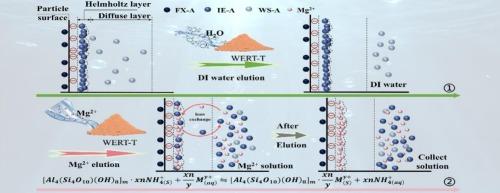梯度洗脱法处理风化壳洗脱沉积稀土尾矿中的残铵
IF 5
2区 工程技术
Q1 ENGINEERING, CHEMICAL
引用次数: 0
摘要
风化壳淋溶稀土矿的原位浸出产生大量的铵盐残留物,可能造成环境污染。为了解决这一问题,本研究开发了一种新的梯度洗脱方法,结合顺序去离子水和0.02 mol/L MgCl2洗脱,针对不同结合的铵组分进行高效去除。实验结果表明,梯度洗脱法对NH4+的去除率为1290.0 mg/kg,显著优于单一去离子水洗脱法(163.3 mg/kg)或0.02 MgCl2洗脱法(1146.8 mg/kg)。与单一Mg2+洗脱法相比,梯度洗脱法在平衡状态下每kg尾矿的MgCl2消耗也减少了244.0 g。同时脱除钙离子253.9 mg/kg、硝酸盐135.8 mg/kg、硫酸盐125.5 mg/kg,降低了二次污染风险。机理分析表明,去离子水优先从扩散层中提取弱结合的水溶性铵,而Mg2+随后通过离子交换反应取代了Helmholtz平面上的离子交换铵。这种双阶段策略克服了单步洗脱的低效率,优化了试剂的使用,同时最大限度地去除污染物。所提出的方法为稀土尾矿修复提供了一种经济可行且环境可持续的解决方案,对最小化浸出后污染的工业规模应用具有重要意义。本文章由计算机程序翻译,如有差异,请以英文原文为准。

Gradient elution method for treating the residual ammonium from the weathered crust elution-deposited rare earth tailings
In-situ leaching of weathered crust elution-deposited rare earth ores generates substantial ammonium salt residues, which might cause environmental contamination. To address this issue, this study developed a novel gradient elution method combining sequential deionized water and 0.02 mol/L MgCl2 elution, targeting differently bound ammonium fractions for efficient removal. Experimental results demonstrated that gradient elution method achieved a remarkable NH4+ removal efficiency of 1290.0 mg/kg, significantly outperforming single deionized water elution (163.3 mg/kg) or 0.02 MgCl2 elution (1146.8 mg/kg). Compared with single Mg2+ elution, the gradient elution method also reduced MgCl2 consumption by 244.0 g per kg of tailings at equilibrium. Furthermore, it simultaneously removed 253.9 mg/kg of calcium ions, 135.8 mg/kg of nitrate, and 125.5 mg/kg of sulfate, mitigating secondary pollution risks. Mechanistic analysis revealed that deionized water preferentially extracts weakly bound water-soluble ammonium from the diffuse layer, while Mg2+ subsequently displaces ion-exchangeable ammonium in the Helmholtz plane via ion exchange reaction. This dual-stage strategy overcomes the inefficiency of single-step elution, optimizing reagent use while maximizing contaminant removal. The proposed method offers an economically viable and environmentally sustainable solution for rare earth tailings remediation, with significant implications for industrial-scale applications in minimizing post-leaching pollution.
求助全文
通过发布文献求助,成功后即可免费获取论文全文。
去求助
来源期刊

Minerals Engineering
工程技术-工程:化工
CiteScore
8.70
自引率
18.80%
发文量
519
审稿时长
81 days
期刊介绍:
The purpose of the journal is to provide for the rapid publication of topical papers featuring the latest developments in the allied fields of mineral processing and extractive metallurgy. Its wide ranging coverage of research and practical (operating) topics includes physical separation methods, such as comminution, flotation concentration and dewatering, chemical methods such as bio-, hydro-, and electro-metallurgy, analytical techniques, process control, simulation and instrumentation, and mineralogical aspects of processing. Environmental issues, particularly those pertaining to sustainable development, will also be strongly covered.
 求助内容:
求助内容: 应助结果提醒方式:
应助结果提醒方式:


